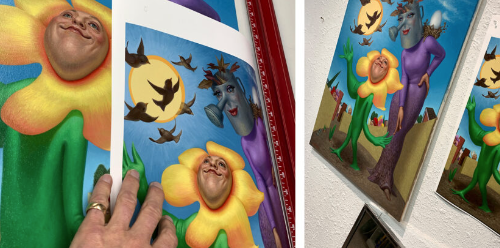Archival Art Prints from Original Paintings
Why Quality Matters

There’s more to a fine art print than just paper and ink. And it shows. The process of recreating an image on paper will determine the quality of the final piece. When all these steps are completed, the result is an archival quality recreation that can be passed through the years and retain its magnificence.
The Paper
As we know by the number of paper products that surround us, there are many different types of paper. Each type of paper is suited to its particular use and how long it is intended to last. The paper used for printed artwork plays an important part in colour appearance, saturation, and preservation of a piece. A paper’s material, weight, coating, acid/ph, texture, and colour all contribute to the final display and longevity of the artwork. Archival art prints aren’t technically archival if they are printed on paper used for short term printing needs. This is why ‘archival’ acid-free paper is so important to long-lasting artwork.
Why ‘Acid-free’ Matters
In order for the artwork to retain its original appearance, its permanence depends on the acid content of the paper and materials used. You can tell when the paper isn’t acid-free; chances are you have a book that you remember having white pages that are slightly faded and orange. To stand the tests of time, prints from our shop use acid-free paper to create an archival art print that can remain bright and vibrant.
Artwork is the same, either when directly applying mediums such as paint or pencil on paper or when creating prints from original artwork. This acid tint can affect the vibrance and colour of the print inks and create unexpected changes over time.
Who knew there was so much acid in paper products. To really go deep on the subject, this wiki elaborates on the causes of paper degradation and the consequences of high acid content.
Framing tip! While it’s important to use acid-free paper for printing, it’s also important to use an acid-free backing when framing the print to prevent acid deterioration from starting at the backside of the paper. Look for the word ‘archival’ or ‘conservation’ to preserve the front and back surfaces of your archival art print.
Ink and possibility of colour
Accurately recreating an image from an existing painting depends on a balance of tone, shadow and pigment. When one of those is off, it throws off the entire image and sometimes the message of the artwork. Like in the piece ‘Pleasure of Heaven’, a grey angel paints an also grey apple from neutral to bright vivid red. Without that specific tint of red, it would look like sugary molasses and would change the message of the image.
Printers print images using a combination of 4 inks to make the acronym ‘CMYK’ – Cyan, Magenta, Yellow and Black. This means that the colours we see correctly on the screen through RGB (Red Green Blue) will look muted or faded when printed using CMYK. This makes printing specific greens, oranges and reds impossible.
Printing a recreation of a painting with ink and paper (aka an art print) requires perfect colour matching and printers that handle more than 4 colours.

Comparing the various reds of the printing process on ‘Pleasure in Heaven’ print
Hands-on Colour Matching for days
After securing the right printers, papers and ink, the long process of colour matching begins! Each art print is created using a high definition scan of the original painting. This original acts as the reference point for the final print. Back and forth and over many sittings, image files are subtly adjusted on the computer and printed to compare with the original. What looks right on screen doesn’t always match when printed and this process continues till it’s perfect.

Comparing print to print, print to painting and painting to print to make sure the colour is right for the ‘Rooted Flight’ print
How it all comes together
There is more to creating a vibrant and accurate recreation than taking a photo and pressing the print button. It is through incremental and tedious steps that the magic of the original oil painting shines through, to reveal energetic vibrant colours and hidden details in the shadows.

Details of the process: Removing light and dust from the original artwork to prepare it for high res printing. See the results of ‘Angel Song’, here
To be the original artist of these images and to see how well the print process captures the magic and nuance is really exciting after years of trying and never feeling satisfied with what was produced. To have the control and ability to achieve this level of reproduction is inspiring for creating and recreating more works in the future. From the camera or scanner capturing the original art to the gloss and absorbency of the paper – Printing digital images is an exciting science that opens the doors for more artists to share their creations in the form of archival art prints.

